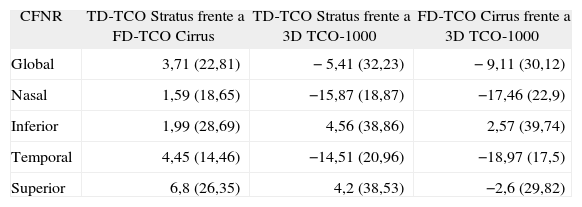Determinar la concordancia entre un sistema de tomografía de coherencia óptica (TCO) time-domain (Stratus) y dos sistemas de TCO Fourier-domain (Cirrus y 3D TCO-1000) en la determinación del grosor de la capa de fibras nerviosas de la retina (CFNR).
MétodosSe incluyeron 50 ojos de 25 pacientes con patología neurooftalmológica de la vía visual aferente. A todos los pacientes se les realizó en ambos ojos, el mismo día y por el mismo operario, un triple examen de TCO de la CFNR con Stratus, Cirrus y 3D TCO-1000. El grosor medio de la CFNR global, por cuadrantes y por sectores horarios fueron comparados mediante el coeficiente de concordancia de Lin (CCC) y figuras de Bland-Altman.
ResultadosEl grosor de la CFNR global, de los cuadrantes temporal y nasal y de los sectores horarios correspondientes estimado mediante 3D TCO-1000 fue el más alto (global, 90,02μm), en cambio, el grosor de la CFNR en los cuadrantes superior e inferior y en los sectores horarios correspondientes fue mayor con Stratus. El CCC entre Stratus y Cirrus fue alto (0,820), en cambio, la concordancia entre Stratus y 3D TCO-1000 fue moderada globalmente (0,573) y entre Cirrus y 3D TCO-1000 resultó moderada de forma global (0,564), pero muy baja en los cuadrantes nasal y temporal (0,362 y 0,347 respectivamente).
ConclusionesLos espesores medios de la CFNR obtenidos mediante los TCO Stratus, Cirrus y 3D TCO-1000 no son equivalentes. Aunque la concordancia entre Stratus y Cirrus es alta, entre 3D TCO-1000 y Stratus o Cirrus es muy baja.
© 2009 Sociedad Española de Oftalmología. Publicado por Elsevier España, S.L. Todos los derechos reservados.
To assess agreement between one system of time-domain optical coherence tomography (OCT) (Stratus) and two systems of fourier-domain OCT (Cirrus and 3D OCT1000) for the measurement of the retinal nerve fibre layer thickness (RNFL).
MethodsFifty eyes from 25 patients with neuro-ophthalmological disorders of the afferent visual pathway were included. A triple RNFL thickness OCT examination with Stratus, Cirrus and 3D OCT-1000 was performed on both eyes of every patient, on the same day and by the same technician. The average RNFL thickness by quadrants and clock sectors were compared with the Lin's concordance correlation coefficient (CCC) and Bland-Altman plots.
ResultsThe average RNFL thickness, the temporal and nasal quadrants and corresponding clock sectors, was higher by 3D OCT-1000 (mean 90.02 microns), nevertheless, RNFL thickness of the superior and inferior quadrants and corresponding clock hours was higher when measured by Stratus device. The CCC agreement between Stratus and Cirrus was high (0.820), between Stratus and 3D OCT-1000 was moderate (mean 0.573) and between Cirrus and 3D OCT-1000 was moderate with a mean of 0.564 but too low in the nasal and temporal quadrants (0.362 and 0.347 respectively).
ConclusionsThe RNFL thickness measurements by Stratus, Cirrus and 3D OCT-1000 OCT are not equivalent. Although the agreement between Stratus and Cirrus was high, it was too low between 3D OCT-1000 and Stratus or Cirrus.
© 2009 Sociedad Española de Oftalmología. Published by Elsevier España, S.L. All rights reserved.
Artículo
Comprando el artículo el PDF del mismo podrá ser descargado
Precio 19,34 €
Comprar ahora















